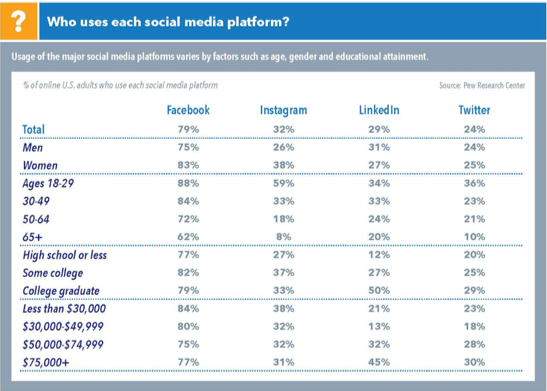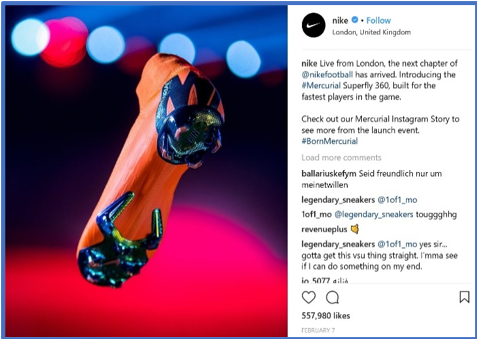Just as everyone has their own unique personality, so does each social media platform. It is imperative that you do not post the same content in every social media environment. What you tweet will not play as well as a Facebook post and vice versa. The content needs to fit well in each platform’s personality. What, when, and how often you post all need to be adapted to the platform. That said, your business does not need to be active on all platforms. Take a look at your target demographic and see which platform matches up with the data on the right.

While users on other platforms fire out posts multiple times a day, you should post to Facebook 2-3 times a week. Quality
over quantity is the rule for Facebook. Non-business Facebook users normally post life events, photos and videos. You should not post so often that you dilute viewers’ news feeds with your ads/posts!
Facebook has always been about driving conversations and relationships and your posts should reflect that! The best post types include live video, pictures, and stories. These three types allow your business to communicate with viewers with a more conversational tone. Though hashtags are popular on other platforms, do not use them on Facebook because it takes away part of the conversational tone.

Even though Facebook owns Instagram, the two platforms have very different personalities. Instagram is a more artistic, visual platform. Artsy pictures with less human faces are more common. Of all the platforms, Instagram gives brands the best opportunity to grow rapidly. To do that, you need a consistent branding message that drives users to become part of your network. Have a consistent, identifiable brand so that users can quickly identify which posts are yours.
On Instagram, posting once a day with lots of hashtags is encouraged. Remember, links are only clickable on your profile page. Call users to visit your page and click on that link. Instagram offers a unique opportunity to market your products. Even if your company isn’t “sexy”, you can still use Instagram to your advantage. Consider posting images of employees in their natural environment, company philanthropy or your product in use.

While Instagram and Facebook focus on visual content, Twitter focuses on short and sweet content. Though images can still be used, the text in tweets are more important. Instead of posting a long story, give the headline of a story with a link to the full article (keep the URL short). Post frequently to Twitter to keep these quick hitting messages at the top of viewers’ minds.
Hashtags are critical in your twitter posts and each post should include 2-3. They allow you to be discovered by users that are not in your network already. Keep an eye out for trending hashtags that are relevant to your business. Questions are also effective on twitter. The question makes the user’s brain think about the answer, which means they are spending more time on your content. Look to interact with other users and brands.

LinkedIn is considerably different from the other social media platforms. The key difference is it is business focused, but still social. The focus is still interaction with viewers, but keep thinking what they expect to interact with. Facts, not opinions, dominate LinkedIn. LinkedIn offers the opportunity to teach valuable insights to followers. Posts should include keywords with longform content relevant to your business. Do not be afraid to comment on other posts. It expands your network and engages other industry professionals.
Because of the business focus, what you post should be different. Instead of artsy photos, post industry-focused content that is relevant to business users. Content marketing plays very well on this platform. On LinkedIn, the post does not always come from your business page. Encourage your employees to post on LinkedIn so that your audience expands to your employee networks, not just your page.
Summing It Up
Your business does not need to be involved in every social media platform. Feel free to pick only one or two. But, it is imperative that you understand the best ways to use each different personality. Take a detailed look into which target market you are serving and choose which platform best lines up. From there, tailor your posts and content to which styles are most effective on the platform. With more knowledge on the medium your network is viewing content, your posts will have an increased chance in your customers interacting with your business.
